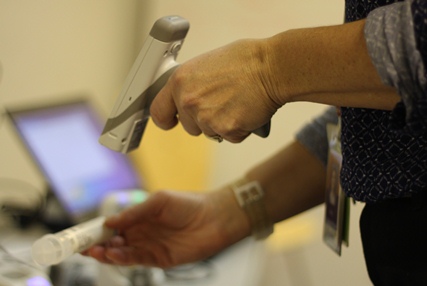Selecting the CST devices we need
Having stepped out of the operating room at Vancouver General Hospital a few months ago, Pamela Dawkins knows the importance of selecting the right devices for the Clinical & Systems Transformation (CST) project. That’s why this experienced nurse joined the CST team as Clinical Device Lead.
“I am a nurse first. I look after my patients and now, being involved with CST, my patient list has grown to include patients across the three Health Organizations,” says Pamela. “I want to make sure everyone gets the best care and these devices will help achieve this.”
Clinical devices in scope for the project are Workstations on Wheels (WOWs), Medication Carts and Barcode Scanners. These devices are undergoing a rigorous selection process that includes usability evaluations, to ensure they meet the needs of our staff.
Workstations on Wheels and Medication Carts have a computer that accesses the new clinical information system and a Barcode Scanner. They allow staff to view electronic charts and use single sign-on technology while at the patient’s bedside or doing rounds.
Using a Barcode Scanner on patient identification and medication packages, the information appears in the system automatically – an important part of achieving Closed Loop Medication Management.
Pamela has been working with Tanico Tan, CST Device Lead, to select quality device options that will work for the people who will be using them every day.
“We’re giving options for devices that will best fit the workflow of different care areas,” says Tanico. “The CST Device team will ensure the devices that are selected by clinicians are technically sound, work seamlessly within our clinical and technical environments and have a solid support model.”
Before each site goes live with CST, the Device Team will offer recommendations and work with each area to determine what devices are needed and where they should go. They will also work with sites to assess power availability, network connectivity and other key considerations.
Additional devices to be implemented as part of CST are label printers, document scanners, tracking boards and single sign-on card readers. There are also standard devices defined by Health Shared Services BC (HSSBC), including workstations, laptops and laser printers.
Pamela says the team learned from North York General Hospital, who have Cerner too, that many of their clinicians asked for tablets prior to go-live. The tablets were soon passed over in favour of Workstations on Wheels, due to larger screens and the ability to properly view the electronic medical record.
“Change can be scary and disruptive, and we want to be there to make sure the clinical end user voice is heard. We are all here for the patient,” says Pamela. “These devices will let you focus more on patients and less on chasing paper.”
Please read our FAQs for more information on devices.
Background information
• CST is a joint initiative of VCH, PHSA and PHC, and one of the largest and most complex healthcare projects in Canada. It spans across several areas of the continuum of care, including: acute care inpatient and outpatient units and ambulatory care. As well as creating consistent, leading practices, and a shared clinical information system, CST will deliver HIMSS Level 5 functionality.
• Clinical design teams, made up of hundreds of highly-skilled, multi-disciplinary professionals from across the three Health Organizations and Team IBM (experts from IBM Technical Services, Deloitte, Leidos Solution Builders and the University of Pittsburgh Medical Centre), started work on April 7, 2014. These teams are tasked with designing our future workflows, based on leading practices. In doing so, they are defining the requirements for our new clinical information system.
For more information, please contact Donna Stanton, CST Executive Director/Transformation Lead, VCH at donna.stanton@vch.ca.
You’re invited to submit suggestions for future articles. If you have questions or feedback, please email info@CSTproject.ca.

